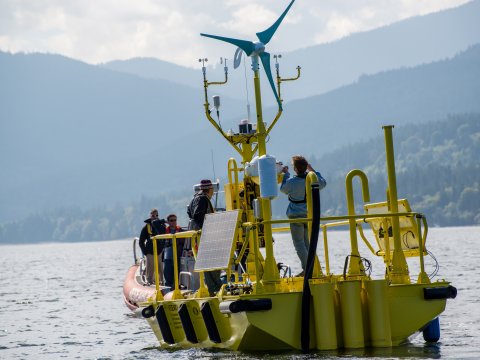Offshore wind farms along state and federal shores have the technical potential to provide more than 2,000 gigawatts of capacity. Developing just 1% of this potential could power nearly 6.5 million homes. So what’s the holdup?
Site assessment and permitting are two significant factors in the offshore wind project development. Determining the consistency of wind and how much power a site can yield can be a long and expensive process, between securing the required permits, potentially building a meteorological tower, and gathering the necessary years’ worth of data. This is time consuming and potentially cost prohibitive in the early stages of project development.
To accelerate the development of offshore wind, DOE’s Wind Energy Technologies Office commissioned Pacific Northwest National Laboratory (PNNL) to procure and deploy two research buoys designed to more accurately predict the power-producing potential of a site. The bright-yellow buoys—each worth $1.3 million—are decked out with advanced scientific instruments designed to measure wind speed at multiple heights, air and sea surface temperature, barometric pressure, relative humidity, wave height and period, and water conductivity. Doppler sensors measure subsurface ocean currents.After a 19-month deployment off the coast of Virginia Beach, one of the buoys has returned to shore. In collaboration with the state of Virginia, PNNL examined the quality of the data and discovered that stronger winds produced more accurate data—likely as a result of the additional sea spray high winds generate. The increase in spray provides more particles for the lidar signal to bounce off of, improving signal strength and return rates. Similarly, researchers found data recovery rates are higher during the warm season and the daytime.
PNNL also found that above 90 meters (180 feet), signal noise affected the integrity of the data. Further analysis revealed that by removing samples with low signal strengths and averaging data across 10-minute intervals, accurate results could be achieved. Additional analysis performed by researchers at Texas Tech University found offshore winds in the United States differ from European offshore environments. In the United States, winds are more sheared, changing velocity and direction more frequently at lower levels in the atmosphere (called low-level jets). Although low-level jets do not significantly impact the power performance of an offshore wind turbine, their occurrence might lead to inaccurate assessment of the resource as well as increased fatigue loading on wind turbine components.
The data and buoys will help scientists and developers better understand air-sea interactions and their impact on how much wind energy a turbine could capture at particular offshore sites. The data will also help validate the wind predictions derived from computer models, which have thus far relied on extremely limited real-world observational data in U.S. coastal waters.
Visit PNNL for additional information about the Energy Department lidar buoys or access the report directly.


